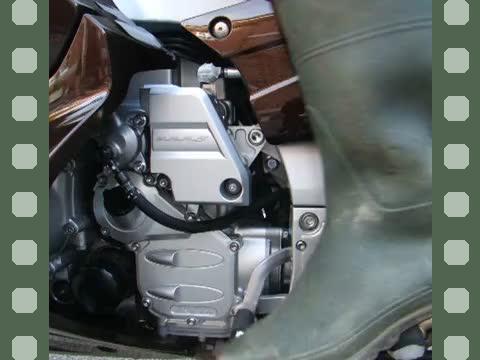wfooshee
O, Woe is me!!
Mine is the one referenced above with the broken shifter. I'd been having the 2nd-gear-skip issue that is fairly common on FJRs, and on many other bikes, too. 4th wasn't jumping or skipping but I did get the occasional false neutral going to 4th from 3rd. When the star cam broke (the weld holding it on the shift drum broke cleanly) I decided to have a look at everything else while in there, and not just replace the shift drum.
My 4th gear dogs showed extreme wear, with beveled edges present on both the dogs and the holes they mate in to. A strong, deliberate shift always worked, but sometimes that lazy kick while you're just zipping along wouldn't quite reach and I'd get a false neutral. Clutch, kick back down, pull again in 3rd, then shift again and it would shift properly.
The beveled edges induced a force pushing the gear towards disengagement, resisted only by the shift fork being in place. That wore the gear wheel and the shift fork enough that critical measurements were not required. Metal was visibly missing on both the fork and the gear. We weren't talking about thousandths, or even hundredths of an inch, it was all in that first decimal place. Well, OK, the gear might have taken two places....
Point is, my 4th gear was well on its way to total uselessness. Had I not been digging about because of the failed weld on the star cam, I would have been digging about within a year because of being unable to reach or use 4th gear.....
As for the question of sitting at the light in first instead of neutral, the gearbox doesn't care. Shifting to first from neutral is no big deal. It's less clunky if you give a rev before grabbing the clutch to kick down, which gets the input shaft spinning, which gets the one side of first gear spinning better for the shift.
The thing you do NOT want to do is stop in 3rd or higher and try to get down to first while stopped. When clutched in any gear and stopped, there is NO MOVEMENT in the transmission. Trying to shift will force a dog into a solid surface rather than empty space at least half the time. That's why the suggestion, if you find yourself there because of a panic stop or something, to shut the engine off and shift gently while rolling the bike back and forth, and leaving the clutch alone. (Good luck with that, AE owners!)
Never sit on a bike in the showroom and work the shifter!!!!!!
My 4th gear dogs showed extreme wear, with beveled edges present on both the dogs and the holes they mate in to. A strong, deliberate shift always worked, but sometimes that lazy kick while you're just zipping along wouldn't quite reach and I'd get a false neutral. Clutch, kick back down, pull again in 3rd, then shift again and it would shift properly.
The beveled edges induced a force pushing the gear towards disengagement, resisted only by the shift fork being in place. That wore the gear wheel and the shift fork enough that critical measurements were not required. Metal was visibly missing on both the fork and the gear. We weren't talking about thousandths, or even hundredths of an inch, it was all in that first decimal place. Well, OK, the gear might have taken two places....
Point is, my 4th gear was well on its way to total uselessness. Had I not been digging about because of the failed weld on the star cam, I would have been digging about within a year because of being unable to reach or use 4th gear.....
As for the question of sitting at the light in first instead of neutral, the gearbox doesn't care. Shifting to first from neutral is no big deal. It's less clunky if you give a rev before grabbing the clutch to kick down, which gets the input shaft spinning, which gets the one side of first gear spinning better for the shift.
The thing you do NOT want to do is stop in 3rd or higher and try to get down to first while stopped. When clutched in any gear and stopped, there is NO MOVEMENT in the transmission. Trying to shift will force a dog into a solid surface rather than empty space at least half the time. That's why the suggestion, if you find yourself there because of a panic stop or something, to shut the engine off and shift gently while rolling the bike back and forth, and leaving the clutch alone. (Good luck with that, AE owners!)
Never sit on a bike in the showroom and work the shifter!!!!!!
































